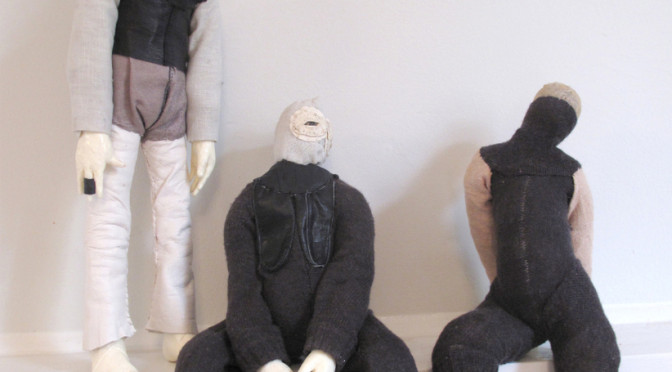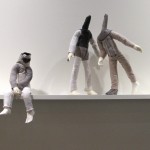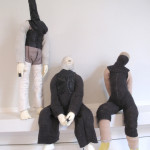The Prosopopoeias (Counihan Gallery, 23 January – 15 February, 2015) by Olivia Pintos-Lopez is an intriguing installation of enigmatic figures made from a combination of cast resin, metal armature, cotton, kid leather, linen, muslin, antique lace, wool embroidery, brocade, buttons, beads, coral, teeth, bone, feather, metal, seeds, shell, stick, gold leaf, cloves, lavender, photographs, thread. The text is from the opening speech by Sarah Tomasetti and images of works are below.
Let’s start with the question on everyone’s lips, What is a prosopopoeia?
Wikipedia informs us thus
A prosopopoeia is a rhetorical device in which a speaker or writer communicates to the audience by speaking as another person or object.
Prosopopoeiae can also be used to take some of the load off the communicator by placing an unfavorable point of view on the shoulders of an imaginary stereotype. The audience’s reactions are predisposed to go towards this figment rather than the communicator himself.
(I think I would like one of those with me all the time to take the rap for my own unfavourable points of view.)
It is interesting that we are speaking of communication here because most of the figurines don’t have faces, let alone mouths. They seem to express a somewhat incoherent state of voicelessness, yet further on we read…
Quintilian writes of the power of this figure of speech to ‘bring down the gods from heaven, evoke the dead, and give voices to cities and states.’
And so via the transformative power of the prosopopoeia we move from this state of voicelessness to bringing down cities and states! (To interpret the idea loosely.) And we do indeed encounter something utterly powerful and compelling in the way these figurines of humble size seem to give form to our own countless unexpressed longings and objections and passing moments of humour.
My first entry to this exhibition was via two of these figurines bought from Olivia’s last Melbourne exhibition and followed by an exchange of materials in which I gave her some gloves and hankies and other things from my grandmother’s collection to be repurposed.
Encountering this new body of work I am struck once again by a sense of connection, an obsessive feeling of needing to own certain pieces. I see a lot of art and collect very little, – in fact sometimes as an artist I can wish not to have too many other voices around me – so to what can I put this down? I think it is the uncanny way that the prosopopoeias seem to give expression to interior states, to literally bring them into being in some way that seems essential to ones inner life. (I did notice a number of people prowling about as I was, mourning ones that were gone, and trying to make the next cathexis quickly before it too was snatched away.)
There is a sense that the gesture or feeling or unconscious state is literally found through making, and as Olivia has described it, at the point that it is fully realised, she stops, sometimes quite abruptly. The last gesture or stitch or wrapped thread has been made, sometimes quite violently, and there is no need to go on. Something has been made coherent, exists more solidly than before. I would posit that the primary essentialness of the process is echoed in the strong response that is going on in the prowling viewers.
They are not primarily about making a thing of beauty. They are more direct than this, more necessary.












 Roseanne Bartley is presenting a series of three
Roseanne Bartley is presenting a series of three 

